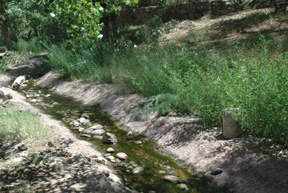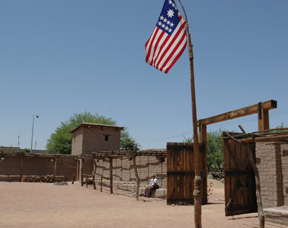Old Las Vegas Mormon Fort State Park
Early Mormon missionaries divert stream to establish outpost in the Las Vegas valley.
LeRoy W. Hooton, Jr.
June 7, 2007
|
Like the first settlement in the Salt Lake valley where the pioneers diverted City Creek stream, the missionaries diverted the Las Vegas Creek fed by springs to grow crops and sustain their existence.
An 150-foot-square fort built of sun-dried adobe was established in a location several blocks north of todayís downtown Las Vegas at the corner of Las Vegas Boulevard and Washington Avenue. The fort walls were 14-feet high with peepholes located 6-feet from the ground to view the outside. The settlementís spring sources of water originated about 4-miles west of the site and flowed through the fort in the Las Vegas Creek. In 1905 when the City of Las Vegas was incorporated, the spring water was diverted into the municipal water system, mostly drying up the creek. Like the first pioneers arriving in the Salt Lake valley, one of the missionariesí first task was to clear the land and plant crops.
Today, a re-created stream flows through a Nevada State Historic Park, which was established in 1991.
While the population grew in hundreds of Mormon colonies within the Great Basin, the Las Vegas venture was short lived. The Mormon missionaries left in 1857, after less than two years of inhabiting the fort. The dearth of precipitation, poor soil and extremely hot summer temperatures that reach 120 degrees probably contributed to the short stay. Mormon colonization efforts were successful in much of the Great Basin but failed in the then inhospitable region of the southwest.
The Las Vegas valley (Clark County) has dramatically changed since the Mormonís first settled the area and built the fort. With the railroad reaching the valley in 1902 and later with the construction of Hoover Dam, Clark County has grown and is now a major destination for millions of visitors. Legalized gambling and growth of the gaming and entertainment business have spurred soaring visitation and population growth. If gaming is the economic engine, Lake Mead is part of the water supply engine supporting the business and population growth of the valley.
Besides Nevadaís allotment of 300,000 acre-feet of Colorado River water in Lake Mead, Clark County water suppliers have tapped about 375,000 acre-feet of ground water from deep aquifers within the valley. Currently an additional 200,000 acre-feet of water is being sought from ground water supplies north of Las Vegas in Lincoln, White and Pine counties. Clark County is one of the fastest growing communities in the United States. In 1905 the population was several thousand, today it is over 2 million with between 4,000 to 6,000 new residents every month.
|
In the midst of this explosive growth of a desert megalopolis, there is still a reminder of the early Mormon settlement in the Las Vegas valley where the first European architectural structures were constructed, crops irrigated and people lived and struggled against the harsh environs of this region of the West. The Old Las Vegas Mormon Fort State Historic Park memorializes the early methods of colonizing the arid West, capturing this wonderful piece of history for future generations to view and appreciate.

